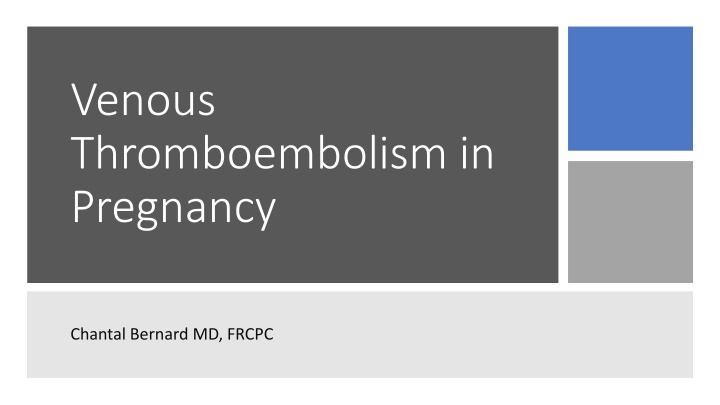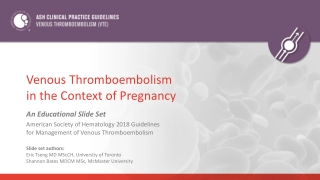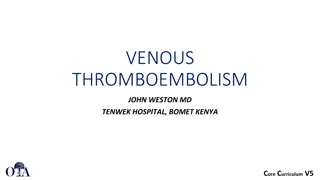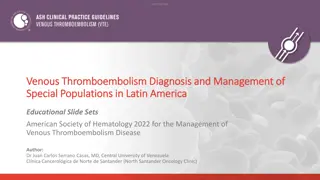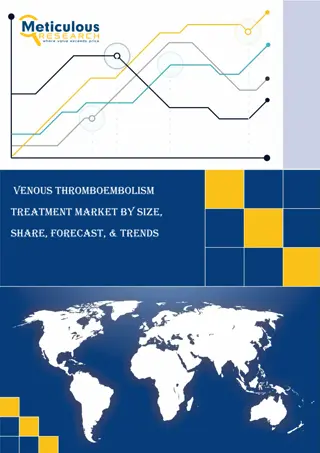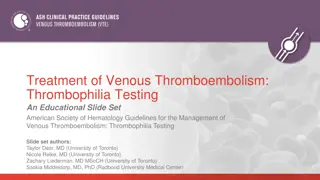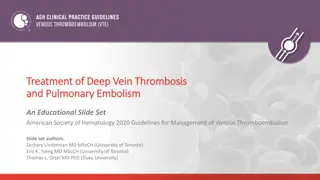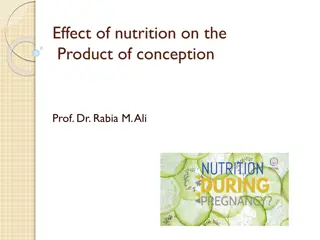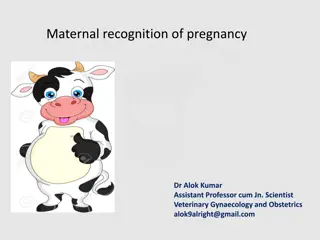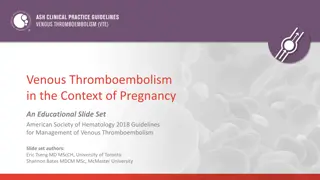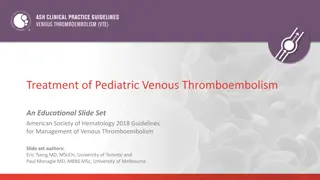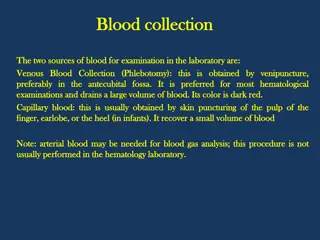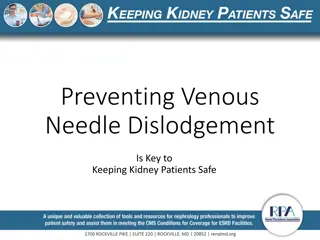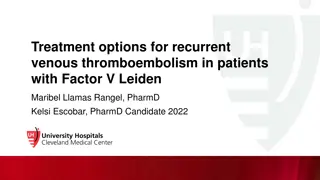Venous Thromboembolism in Pregnancy: Risk Factors and Management
the risks, signs, and prevention of venous thromboembolism during pregnancy, along with essential considerations for diagnosis and treatment. Understand the implications and potential complications associated with VTE in pregnant individuals.
Download Presentation

Please find below an Image/Link to download the presentation.
The content on the website is provided AS IS for your information and personal use only. It may not be sold, licensed, or shared on other websites without obtaining consent from the author.If you encounter any issues during the download, it is possible that the publisher has removed the file from their server.
You are allowed to download the files provided on this website for personal or commercial use, subject to the condition that they are used lawfully. All files are the property of their respective owners.
The content on the website is provided AS IS for your information and personal use only. It may not be sold, licensed, or shared on other websites without obtaining consent from the author.
E N D
Presentation Transcript
Venous Thromboembolism in Pregnancy Chantal Bernard MD, FRCPC
Disclosures I have nothing to disclose.
Plan 1) Introduction 2) Signs and Symptoms 3) Risk factors 4) Thromboprophylaxis 5) Diagnosis 6) Treatment 7) Delivery Considerations
Introduction Venous thromboembolism (VTE) in pregnancy: 1.2 of every 1000 deliveries1
Risk of VTE 5-10x increased risk 15-35x Increased risk During pregnancy3 6 weeks post partum3
Pregnancy-related deaths o USA 2011 to 20132 o VTE is cause #6 of death (pulmonary embolism) o VTE = 9.2% of pregnancy- related deaths o Top causes of death are CV disease, infections and hemorrhage
Signs and Symptoms: DVT Left leg > 80% of the time. Oftentimes isolated iliac or femoral vein thrombosis (no extension from distal veins). Complete leg edema with pain in flank/back. DVT more proximal: higher risk embolization and post- thrombotic syndrome.
Signs and Symptoms: PE Same symptoms as non-pregnant patients: SOB Pleuritic chest pain Tachycardia Desaturation Oftentimes - sx are not indicative of VTE, normal /physiological changes in pregnancy.
Signs and Symptoms Need to be alert to these symptoms. Low threshold to investigate. Means oftentimes investigations will not find VTE good sign.
Advanced maternal age Personal or family history of VTE Post partum hemorrhage or infection, emergency c-section Risk factors of VTE in pregnancy Elevated BMI/Obesity Smoking > 5 cigarettes/day Immobilization >= 7 days Lupus, sickle cell disease, heart disease, cancer Pre-eclampsia with IUGR
Advanced maternal age Personal or family history of VTE Post partum hemorrhage or infection, emergency c-section Risk factors of VTE in pregnancy Elevated BMI Smoking > 5 cigarettes/day Immobilization >= 7 days Lupus, sickle cell disease, heart disease, cancer Pre-eclampsia with IUGR
Thromboprophylaxis 20181 20144
Thromboprophylaxis Patients with personal history of VTE: Situation Antepartum Postpartum up to 6 weeks Prior provoked VTE Non-estrogen related Reversible factor NO YES Prior VTE (unprovoked) Estrogen-related factor* Associated with thrombophilia YES YES * Estrogen-related factor = OCP or pregnancy
Thromboprophylaxis Patients with a thrombophilia : Situation Antepartum Postpartum up to 6 weeks Combined thrombophilias YES YES Homozygous Factor V Leiden YES YES APLA and history of recurrent pregnancy loss YES + ASA 81 mg PO OD YES + ASA 81 mg PO OD
Thromboprophylaxis Patients with a thrombophilia : Situation Antepartum Postpartum up to 6 weeks Homozygous factor II 20210A mutation YES if positive family history of VTE NO if no family history of VTE YES ATIII deficiency YES if positive family history of VTE NO if no family history of VTE YES if positive family history of VTE NO if no family history of VTE Protein S or C deficiency NO Suggested if positive family history of VTE NO if no family history of VTE Heterozygous FVL Heterozygous prothrombin mutation NO NO
Thromboprophylaxis Situation Antepartum Strict antepartum bedrest AND YES while immobilized BMI >= 30 (ASH) or >= 25 (SOGC) at first prenatal visit OR Prior history of VTE
Thromboprophylaxis Agents used: LMWH or UFH. Do not cross the placenta. No increased risk of bleed as compared to non-pregnant women. Dose: DVT Prophylaxis dose Weight > 100-120 kg, consider intermediate dose.
Thromboprophylaxis LMWH Prophylactic dose Intermediate dose Enoxaparin (Lovenox) 40 mg s/c OD 40 mg s/c Q12h or 80 mg s/c OD Dalteparin (Fragmin) 5000 U s/c OD 5000 U s/c Q12h or 10000 U s/c OD Tinzaparin (Innohep) 4500 U s/c OD 10000 U s/c OD UFH Heparin 5000 U s/c Q12h 7500 U s/c Q12h
Anticoagulate Diagnosis of DVT
Anticoagulate Diagnosis of PE5
Prospective study published in March 2019, NEJM. International, multicenter. 498 pregnant patients > 18 years old, suspicion of PE. 46% of patients were in their 3rd trimester.
96% of patients ended up not having any VTE only 1 developed DVT within 90 days follow up. Mostly effective in 1st trimester: managed to avoid CTA in 65% of patients (vs 32% in 3rd trimester).
CT angiography vs V/Q scan CT angiography vs V/Q scan Discussion with patient. CTA: much more increased radiation to mother s breasts concern for breast cancer. Radiation (mGy) V/Q scan CTA Fetal 0.32-0.74 (0.5) 0.03-0.66 (0.1) V/Q scan is considered first line: Perfusion scan only can be considered. Much less radiation for the mother. Safe amount radiation for the fetus. SOGC, ASH and Thrombosis Canada Maternal 1.5 10-70 Consider CXR to evaluate lung parenchyma: 0.1 mGy maternal dose 0.002 mGy fetal dose 100 mGy is dose required for teratogenicity or miscarriage. Accepted upper limit of radiation in pregnancy = < 50 mGy
Treatment of VTE Treatment of VTE in pregnancy in pregnancy
Treatment of VTE in Pregnancy Type of Treatment Pregnancy? Breastfeeding? Considerations DOACs NO NO -Not studied in pregnancy (excluded from clinical trials). -Do cross the placenta. -Found in breast milk. Warfarin NO YES (INR 2-3) -Teratogen (embryopathy and CNS abnormalities). -Can be acceptable during pregnancy in certain situations for certain periods of time (mechanical valves). LMWH UFH Fondaparinux Danaparoid YES YES -Do not cross the placenta. -Used for thromboprophylaxis. -LMWH > UFH: less HIT and osteoporosis
Treatment duration: 3 months minimum full dose anticoagulation. Treatment of VTE in pregnancy If VTE event earlier in pregnancy: VTE prophylaxis dose during the rest of the pregnancy and 6 weeks postpartum. Some experts say to continue full anticoagulation dose, citing that the dose naturally "decreases" with progression of pregnancy (increased weight).
Screening for thrombophilia following first episode of VTE during pregnancy is not indicated. Do screen if family history of thrombophilia and/or VTE in unusual site. Treatment of VTE in pregnancy
Risk of LMWH in pregnancy 0.5% risk antepartum bleeding. Rare risk of subchorionic hematoma. CBC recommended 1 week post start of LMWH to screen for HIT (SOGC).
Delivery Delivery Considerations Considerations
When can I get an epidural? Comments Prophylactic dose of LMWH 12h after last dose Stop when contractions start Treatment dose or intermediate dose of LMWH 24h after last dose Delivery Considerations Prophylactic UFH 4-6 hours after last dose Start this at 36-37 weeks gestation ALWAYS speak to your team of anesthesiologists, practice changes according to center. When to resume prophylactic doses of LMWH: 12 hours after delivery or epidural removal. Speak to OBGYN team: assure hemostasis achieved.
Inferior vena cava filter if < 2 weeks between VTE event and delivery. If between 2-4 weeks, consider IVC filter. IV Heparin drip peripartum: stop 4-6h before active phase of labour and resume ASAP. VTE < 1 month before delivery!
Schedule delivery if therapeutic doses of anticoagulation. Delivery Considerations Suggest against scheduled delivery if on prophylactic doses of anticoagulation.
Planned c-section last dose: LMWH day before Delivery Considerations UFH night before (prophylaxis)
Consider post-partum thromboprophylaxis (often only in hospital) according to risk factors. Delivery Considerations Can continue for up to 6 weeks post-partum according to risk assessment.
Conclusion Conclusion Key points Key points #1: Pregnant women have a 5-10x increased risk of VTE as compared to non-pregnant women of a similar age. The risk increases to 15-35x in the 6 weeks postpartum. #2: Signs and symptoms of VTE in pregnancy can be overlooked because they are similar to normal/physiological changes in pregnancy we must be vigilant! #3: In pregnant patients with personal history of VTE or history of thrombophilia, we must consider if thromboprophylaxis is needed during pregnancy.
Conclusion Conclusion Key points Key points #4: You suspect a deep vein thrombosis? Ask for a doppler U/S first! You suspect a pulmonary embolism? Ask for a V/Q scan! Always counsel the patient on radiation. #5: Outpatient treatment of VTE in pregnancy: low molecular weight heparin (LMWH) is the only option. If breastfeeding: LMWH or Coumadin are options. DOACs are not approved in pregnancy.
References 1. Bates, S. M., Rajasekhar, A., Middeldorp, S., McLintock, C., Rodger, M. A., James, A. H., Vazquez, S. R., Greer, I. A., Riva, J. J., Bhatt, M., Schwab, N., Barrett, D., LaHaye, A., & Rochwerg, B. (2018). American Society of Hematology 2018 Guidelines for management of venous thromboembolism: Venous thromboembolism in the context of pregnancy. Blood Advances, 2(22), 3317 3359. https://doi.org/10.1182/bloodadvances.2018024802 2. Hirshberg, A., & Srinivas, S. K. (2017). Epidemiology of maternal morbidity and mortality. Seminars in Perinatology, 41(6), 332 337. https://doi.org/10.1053/j.semperi.2017.07.007
References 3. Pregnancy: Diagnosis of DVT and PE - thrombosis Canada. Thrombosis Canada. (2021, September 14). Retrieved April 2, 2022, from https://thrombosiscanada.ca/wp-content/uploads/2020/07/Pregnancy- Diagnosis-of-DVT-and-PE_10July2020-1.pdf 4. Chan, W.-C., Rey, E., & Kent, N. (2014, June). Venous Thromboembolism and Antithrombotic Therapy in Pregnancy. SOGC Clinical Practice Guideline. Retrieved April 2, 2022, from https://www.jogc.com/article/s1701-2163(15)30569-7/pdf 5. van der Pol, L. M., Tromeur, C., Bistervels, I. M., Ni Ainle, F., van Bemmel, T., Bertoletti, L., Couturaud, F., van Dooren, Y. P. A., Elias, A., Faber, L. M., Hofstee, H. M. A., van der Hulle, T., Kruip, M. J. H. A., Maignan, M., Mairuhu, A. T. A., Middeldorp, S., Nijkeuter, M., Roy, P. M., Sanchez, O., Huisman, M. V. (2019). Pregnancy- adapted years algorithm for diagnosis of suspected pulmonary embolism. Obstetric Anesthesia Digest, 39(3), 138 139. https://doi.org/10.1097/01.aoa.0000575160.60423.90
Treat if (SOGC): Bilateral Very symptomatic <= 5 cm from deep veinous system Length >= 5 cm Treat with LMWH prophylactic dose. Treat for up to 6 weeks. If you do not treat initially be sure to follow up closely. Superficial Thrombophlebitis
Massive Pulmonary Embolism Evidence limited to case reports and case series. Treat with systemic thrombolytics if: Right ventricular dysfunction and hemodynamic instability Consider half-dose thrombolytics initially, time permitting. Think of possibility of needing to initiate Massive transfusion protocol if post delivery.
